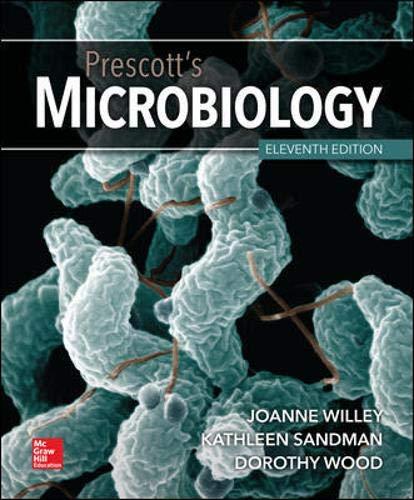
Prescott's Microbiology
11th Edition
ISBN: 9781260211887
Author: WILLEY, Sandman, Wood
Publisher: McGraw Hill
expand_more
expand_more
format_list_bulleted
Concept explainers
Question
Chapter 24.4, Problem 4CC
Summary Introduction
Any eukaryotic organism which is not a plant, animal, or
Expert Solution & Answer
Want to see the full answer?
Check out a sample textbook solution
Students have asked these similar questions
What are the major mechanisms of locomotion found in protists?
What structure distinguishes rhizaria from all other protists?
What are mode of locomotion and general behavior especially differences between ciliate,flagellate, and amoeboid protists?
Chapter 24 Solutions
Prescott's Microbiology
Ch. 24.1 - Prob. 1CCCh. 24.1 - Prob. 2CCCh. 24.1 - Prob. 3CCCh. 24.1 - Prob. 4CCCh. 24.1 - Prob. 5CCCh. 24.1 - Describe vesicular, ovular, and chromosomal...Ch. 24.1 - Why has taxonomic classification of protists been...Ch. 24.2 - Prob. 1MICh. 24.2 - What are the functions of the stigma and the...Ch. 24.2 - Prob. 1CC
Ch. 24.2 - What is the function of the plasmalemma and...Ch. 24.2 - Prob. 3CCCh. 24.3 - Prob. 1MICh. 24.3 - Prob. 2MICh. 24.3 - Prob. 1CCCh. 24.3 - Prob. 2CCCh. 24.3 - Prob. 3CCCh. 24.4 - Prob. 1MICh. 24.4 - What are the functions of the micronucleus and...Ch. 24.4 - How does the trigger for sexual reproduction...Ch. 24.4 - Prob. 1CCCh. 24.4 - Compare how radiolaria use axopodia with the way...Ch. 24.4 - Prob. 3CCCh. 24.4 - Prob. 4CCCh. 24.4 - Describe conjugation as it occurs in ciliates....Ch. 24.4 - Prob. 6CCCh. 24.4 - Prob. 7CCCh. 24.4 - Prob. 8CCCh. 24.4 - Prob. 9CCCh. 24.5 - Prob. 1MICh. 24.5 - Compare the morphology of members of the genus...Ch. 24.5 - Prob. 2CCCh. 24 - Prob. 1RCCh. 24 - Prob. 2RCCh. 24 - Prob. 3RCCh. 24 - Prob. 4RCCh. 24 - Prob. 5RCCh. 24 - Prob. 6RCCh. 24 - Protist encystment is usually triggered by changes...Ch. 24 - Vaccine development for diseases caused by...Ch. 24 - Prob. 3ALCh. 24 - Benthic foraminifera inhabit marine sediments. It...Ch. 24 - Prob. 5AL
Knowledge Booster
Learn more about
Need a deep-dive on the concept behind this application? Look no further. Learn more about this topic, biology and related others by exploring similar questions and additional content below.Similar questions
- What distinguishes protists from prokaryotes? What distinguishes protists from fungi, land plants, and animals?arrow_forwardHow does killing Anopheles mosquitoes affect the Plasmadium protists?arrow_forwardRelative to other unicellular protists, how would you characterize the size of amoebas?arrow_forward
- The internal structure of many protists is much more complexthan that of cells of multicellular organisms. Does thismean that the protist is engaged in more complex activitiesthan the multicellular organism is? If not, why are protistancells more complicated?arrow_forwardWhat Are Protists?arrow_forwardA protist that contains contractile vacuoles most likely lives ______. in ice in a marine environment in fresh water within the cells of another organismarrow_forward
arrow_back_ios
arrow_forward_ios
Recommended textbooks for you
 Concepts of BiologyBiologyISBN:9781938168116Author:Samantha Fowler, Rebecca Roush, James WisePublisher:OpenStax College
Concepts of BiologyBiologyISBN:9781938168116Author:Samantha Fowler, Rebecca Roush, James WisePublisher:OpenStax College Biology: The Dynamic Science (MindTap Course List)BiologyISBN:9781305389892Author:Peter J. Russell, Paul E. Hertz, Beverly McMillanPublisher:Cengage Learning
Biology: The Dynamic Science (MindTap Course List)BiologyISBN:9781305389892Author:Peter J. Russell, Paul E. Hertz, Beverly McMillanPublisher:Cengage Learning Biology (MindTap Course List)BiologyISBN:9781337392938Author:Eldra Solomon, Charles Martin, Diana W. Martin, Linda R. BergPublisher:Cengage Learning
Biology (MindTap Course List)BiologyISBN:9781337392938Author:Eldra Solomon, Charles Martin, Diana W. Martin, Linda R. BergPublisher:Cengage Learning

Concepts of Biology
Biology
ISBN:9781938168116
Author:Samantha Fowler, Rebecca Roush, James Wise
Publisher:OpenStax College

Biology: The Dynamic Science (MindTap Course List)
Biology
ISBN:9781305389892
Author:Peter J. Russell, Paul E. Hertz, Beverly McMillan
Publisher:Cengage Learning

Biology (MindTap Course List)
Biology
ISBN:9781337392938
Author:Eldra Solomon, Charles Martin, Diana W. Martin, Linda R. Berg
Publisher:Cengage Learning
Microbial Nutrition and Growth; Author: Scientist Cindy;https://www.youtube.com/watch?v=rK3UkyWjkl8;License: Standard YouTube License, CC-BY